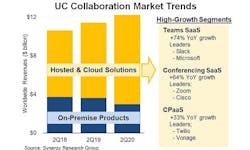Data Bytes: Pandemic Drives Increased Spending on Hosted Collaboration Tools
Data Bytes is a weekly roundup of research and analysis for the data center and cloud computing sector. Want to get it in your Inbox every Monday? Sign up for our DCF news updates.
One of the clear trends emerging from the COVID-19 pandemic has been the increased use of video conferencing to support the work-from-home economy. New data from Synergy Research puts some hard number to that trend. Synergy’s tracking from the second quarter of 2020 shows that spending on UC collaboration tools grew 7% from the second quarter of 2019, reaching over $12 billion.
Most notably, there was a clear shift to third-party services, a trend driven by the speed of the COVID-19 workforce transition, which few in-house operations were equipped to manage smoothly. Spending on hosted & cloud solutions grew by 18%, while spending on on-premise products declined by 18%. Hosted and cloud now accounts for over three quarters of the market. While most hosted and cloud segments are expanding, growth was particularly strong in teams SaaS, conferencing SaaS As a result Zoom, Twilio, Vonage and Slack all now feature strongly in the top 10 ranking of collaboration vendors.
“We were already seeing a steady migration in the collaboration market away from on-premise products and towards cloud solutions. COVID-19 and the sudden radical change in working practices has resulted in an acceleration of that transition,” said Jeremy Duke, Synergy Research Group’s founder and Chief Analyst. “CIOs need to find ways of maintaining communications and productivity in a world where remote working is the new norm and offices are sparsely populated. This is a world for which hosted and cloud solutions are perfectly suited.”
Synergy said pandemic-driven workplace shifts also boosted the video conferencing equipment market, which returned to growth in Q2 after a run of four soft quarters. Worldwide revenues grew 11% compared with the second quarter of 2019. While the USB video conferencing segment continues to grow strongly, it was particularly notable that the traditional video conferencing systems returned to growth in the quarter. Sales of video conferencing equipment were almost $500 million in Q2, driven by 34% year-on-year growth in the USB segment and 3% growth in the traditional systems segment.
“USB technology is more cost efficient and easier to use than traditional video codec systems and is also well aligned with flexible, cloud-based operations,” said Duke. “The Conferencing SaaS market grew by 64% in Q2, driven primarily by VaaS which more than doubled in size. This booming VaaS market is helping to pull through strong demand growth for video conferencing equipment. USB is the main beneficiary but sales of traditional video conferencing end points are also once again on the rise.”
Accenture: Public Clouds Improve Sustainability
Migration to the public cloud can achieve significant carbon reduction in the form of a 5.9% decrease in total IT emissions or nearly 60 million tons of CO2 globally per year, according to new research from Accenture. That’s the equivalent of taking 22 million cars off the road, the frim said.
In a new report title “The Green Behind the Cloud” Accenture says businesses are facing more pressure to solve large socioeconomic challenges and shift toward more responsible and sustainable practices while boosting profitability. The latest Accenture Strategy-UNGC study found 59% of CEOs say they are deploying low-carbon and renewable energy across their operations today while 44% see a net-zero, carbon neutral future for their company. Moreover, two-thirds view technologies like cloud as critical factors for accelerating change and making their commitments a reality.
“Sustainable cloud can deliver a double helix effect of shareholder and stakeholder value by simultaneously reducing costs and carbon emissions,” said Peter Lacy, a senior managing director and global sustainability lead at Accenture. “Further, the magnitude of carbon reduction achieved through cloud migrations can go a long way in meeting climate change commitments and driving new levels of innovation, ultimately leading to a greener balance sheet and a greener planet.”
Adding to the significant environmental impact, sustainable cloud solutions deliver key financial benefits. Accenture’s analysis, based on its work with clients, shows up to 30-40% total cost of ownership savings from public cloud, driven by greater workload flexibility, better server utilization rates and more energy-efficient infrastructure. According to the report, the sustainability and financial benefits from cloud migration will vary based on three key factors: the cloud provider selected, the ambition level for cloud optimization, and the level of cloud-enabled sustainability innovations.
About the Author


